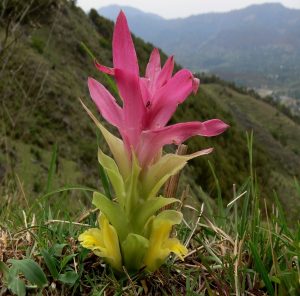BOTANICAL NAME: Curcuma angustifolia
FAMILY: Zingiberaceae
CLASSICAL CLASSIFICATION:
Sushruta:Kakolyadigana
ENGLISH NAME: West Indian Arrowroot
COMMON NAME:
Hindi name: Tavakhira, Tikhura
Bengali name: Tikur
Kannada name: Kuve gadde

BOTANICAL DESCRIPTION:
A horizontal and unbranched, spindle shaped, 12 to 20 cm long and dull white to creamy in color when fresh, prominently marked with nodal rings and scale leaves which completely encircle the nodes; internodal length is 0.5 to 1.5 cm; sliced individual pieces are cylindrical, rough, and size ranges from 1 to 2 cm long and 1 to 2.5 cm across; externally brownish and broken surface off-white; fracture, hard and fractured surface fibrous and starchy; starchy odor and taste.
AYURVEDIC CHARACTERISTICS:
| RASA | GUNA | VEERYA | VIPAKA | PRABHAVA | DOSHGHNTA |
| Madhura | Guru | Sita | Madhura | Rasayana, Balaprada | Pittahara |
AYURVEDIC ENERGETICS:
| TASTE | PROPERTY | POTENCY | POST DIGESTIVE EFFECT | EFFECT ACTION | DOSHA ACTION |
| Sweet | Heavy | Cooling | Sweet | Rejuvenate, strength | Pitta pacifying |
MAJOR CHEMICAL CONSTITUENTS: Starch (25-30%)
THERAPEUTIC USES:
- Strength: 10 gm of tavaksheeri powder is added with a glass of milk and sugar candy.
- Dysuria: 5gm of tavaksheeri powder mixed with milk.
- Cough and Dyspnea: 2-3 gm of tavakasheeri powder is mixed with honey.
INDICATIONS:
Kasa Cough, Agnimandya Digestive impairment, Raktado Disorder of blood
USEFUL PART: Rhizome
DOSAGE: 5 to 10 g daily in powder form
AYURVEDIC FORMULATION:
- Kerakhand granules
- Sitopladi churna
- Talisadi churna
